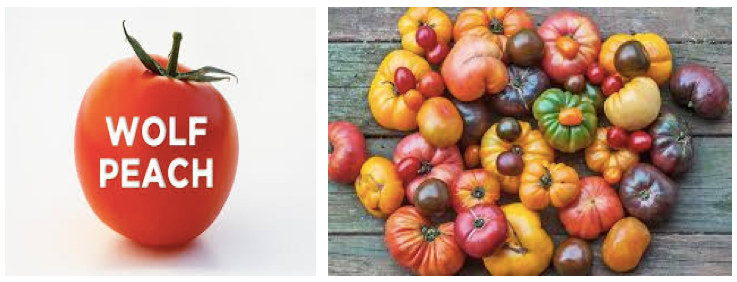[Originally published as part of my Column “Green Cardamoms in Shillong Times, Canvas, page 3].
The WOLF PEACH !
Author: Gaurangi Maitra

Photo credits: www.twitter.com & www.thespruce.com
Memory tags: Gathering material for “Darwin’s Theory of Evolution: Survival of nature’s fit!”
It is fascinating how plants migrate with human conquistadors and travelers! So the small green tomato or “plump fruit with a navel”, may have first travelled from its home in Peru, packed as a exotic curiosity in a traveler’s luggage. Its modern name “tomato” can be traced back to an Aztec word “xitomatl” meaning plump thing with a navel, other Mesoamerican peoples later called it “tomatl”. In older scientific nomenclature, the name for the tomato was Solanum lycopersicum, was based on the belief that it was food for the wolves, so lyco(wolf) + periscum( peach) became "wolf-peach". In Iran, it becomes French plum or “Gojeh Farangi", or depending on what English you speak, ‘xitomatl’ becomes tomeyto ( US of A) or tomaato( old Blighty). The tomato, as part of the Solanaceae plant family, is cousin to the potato, brinjal and tobacco; all of which can apparently claim South America as their ancestral home. Humans probably began cultivating it as early as 500 BC, and from this early ancestral stock the present day varieties of tomato evolved to became an indispensable part of global human diet. Plants and languages, both seem to evolve through natural and artificial selection!
Historical records show Aztecs mixed tomatoes with peppers, corn and salt; was it the original salsa recipe? The Italian Risotto, Spanish Paella and the Southern Indian Tomato Rice, all share rice and tomato as common ingredients. The tomato in the pasta and pizza sauce came to Naples in Italy, via the Mediterranean from Spain. The latter took it to the Caribbean and the Philippines! So popular and well adapted has this vegetable become, that China in the Asian continent, is a top producer, with that a staggering 125 million tonnes produced world wide in 2008! Are all tomatoes red ? No ! They could be exotic yellow, orange, pink, brown, black, ivory, white or purple, striped or fuzzy! Little wonder when there are about 7500 varieties grown for various purposes! Even the rotten tomato has its use. A flop show in the 19th century could earn you a non lethal but messy rotten tomato. La Tomatina is a massive annual tomato fight in the town of Bunol in Spain. The protest value of rotten tomatoes, have made it the logo of the Dutch Socialist Party. To eat, to protest, to puree, to ketchup, to describe a colour, the tomato has become a constant human companion! What would the wolves say ?
Main reference:
- Veena Tandon & Gaurangi Maitra, “Darwin’s Theory of Evolution: Survival of nature’s fit!” in Nature at Work ed.by VP Sharma Published by National Academy for Sciences, India 2010 ISBN:978-81-8489-991-7.
- Wikipedia
